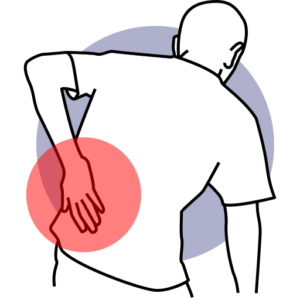LUMBAR SPINAL STENOSIS TREATMENT

Lumbar spinal stenosis is a disease that is characterized by difficulty standing for long periods of time, cramps in the legs, and sometimes complaints in the urinary and intestinal tracts. This disease has symptoms similar to spinal hernia, and sometimes patients can live with it in advanced stages without any symptoms. In addition to surgical methods, different physical therapy alternatives are also applied in the treatment. When the course of the disease cannot be changed with these applications and the patient experiences severe and severe pain, surgical methods are used.
What is Lumbar Spinal Stenosis?
The discs located between the vertebrae have a spongy structure. As people get older, this spongy structure gradually loses its characteristic. It starts to harden due to containing less water. The hardened disks bulge towards the spinal cord and exert pressure. Lumbar spinal stenosis is caused by the narrowing of the lumbar spinal canal in this way. This narrowing can cause serious complaints for some people, while it is not a problem for others.
Diagnosis of lumbar spinal stenosis
Magnetic resonance imaging (MRI) and computed tomography (CT) scans are preferred for the diagnosis of lumbar spinal stenosis. The exact location and severity of the stenosis is determined through these imaging methods and the information is used to understand the gravity of the disease.
Lumbar spinal stenosis, which is observed in advanced ages, is treated with methods applied by patients seeking treatment with complaints such as pain and loss of sensation. Symptoms and complaints include:
- Pain and discomfort in the back and waist area. Unlike spinal hernia, burning and tingling sensations can be felt.
- Severe pain in the legs and cramps as a result. In advanced cases, weakness in the legs and feet is experienced.
- Difficulty in urinating is observed in severe cases. The patient may experience bowel problems.
- Tingling and numbness sensations are experienced.
- The patient is unable to sit for long periods or struggle to stand in buses or waiting areas.
- In walking, an undefined feeling of numbness in the legs is experienced.
- The patient observes that the pain disappears when leaning slightly forward.
What Methods Are Used in the Treatment of Lumbar Spinal Stenosis?
Specialists prefer to use non-surgical methods before surgical methods for patients diagnosed with lumbar spinal stenosis, if the patient is not in a very urgent situation.
Non-surgical methods in the treatment of lumbar spinal stenosis
Among the non-surgical methods for increasing patients’ functional activities in daily life and reducing their pain are medical drugs, such as anti-inflammatory drugs and painkillers. It is important that these drugs are not used excessively and are taken as specified to prevent other side effects.
Regular weekly physical therapy sessions can also lead to a decrease in the pain caused by the stenosis, by gaining flexibility in the body’s muscles, reducing tension and strengthening the muscles over time. Patients who comply with the exercises can observe significant improvements. These non-surgical methods will yield effective results in cases where the disease is just starting and has not progressed much.
Some points are also developed for the patient’s home arrangements. Dishwashers and washing machines are placed at higher locations, so that the patient does not have to bend down. If the bed is not suitable for the patient, it is recommended to be changed. Walking is an important activity in the treatment of this disease, and if necessary, it is supported with a cane.
Other non-surgical treatment methods such as caudal block, transforaminal injection, and radiofrequency are also recommended.
Surgical methods in the treatment of lumbar spinal stenosis
In cases where physical therapy methods are inadequate, and the patient still experiences severe pain and the pain is not relieved by painkillers, despite the exercises, lumbar spinal stenosis surgery is performed. Especially when the patient has problems with urination and bowel movements, such as being unable to walk or move.
The aim of the surgery is to remove the pressure and ensure a wider canal opening, this procedure is called lumbar decompression. In some cases, a slipping condition between the vertebrae may be observed during the lumbar spinal stenosis surgery. To prevent this, a spinal fusion surgery method is used to stabilize the vertebrae. After the surgery, the function of the legs improves, severe pain disappears, and patients can return to their work within 7-9 weeks. It is recommended that patients continue with physical therapy exercises under the guidance of a specialist after the surgery.
Why Choose Us?
At Dr Özgür Akşan – Health Türkiye, we have been providing top-quality neurosurgical treatment options for almost a decade under the guidance and leadership of Op. Dr. Özgür Akşan. Our team is comprised of highly experienced and skilled surgeons, including Dr. Özgür Akşan, Dr. Nail Özdemir, and Dr. Feryal Akşan, all of them having more than 20 years of experience in medicine.
We offer a wide range of treatment options for various neurosurgical conditions, including herniated discs, lumbar spinal stenosis, traumatic brain injury, brain tumors, cervical disc herniation, Chiari malformation, carpal tunnel syndrome, and more. Our team is highly skilled in performing advanced neurosurgical procedures, such as microsurgical discectomy, endoscopic discectomy, spinal fusion instrumentation, craniotomy, craniectomy, gamma-knife radiation therapy, and many more.
At Dr Özgür Akşan – Health Türkiye, we are committed to providing personalized care and tailored treatment plans for each patient based on their unique needs and medical history. Our clinic in Izmir is equipped with the latest technology and we are working with private hospitals with state-of-the-art facilities to ensure the highest level of care for our patients.
Choose Dr Özgür Akşan – Health Türkiye for your neurosurgical needs and experience the expertise and care of our highly trained team of neurosurgeons, led by Dr. Özgür Akşan himself.
